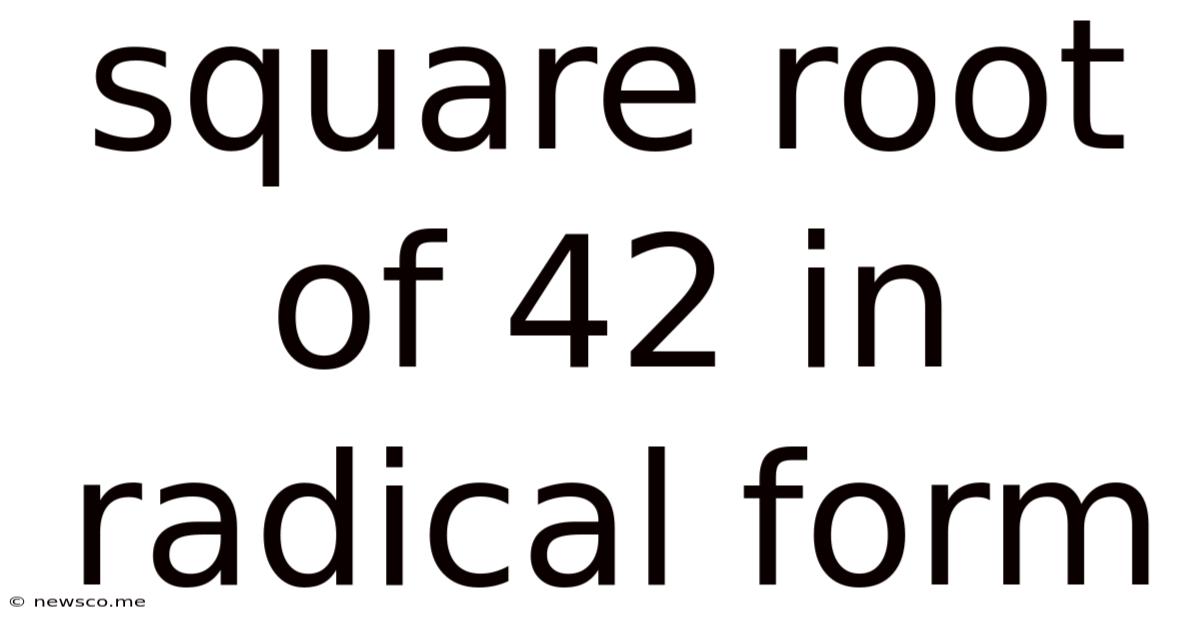Square Root Of 42 In Radical Form
News Co
Mar 26, 2025 · 5 min read

Table of Contents
The Square Root of 42 in Radical Form: A Deep Dive
The square root of 42, denoted as √42, is an irrational number. This means it cannot be expressed as a simple fraction and its decimal representation goes on forever without repeating. While we can approximate its value using a calculator (approximately 6.48), understanding its radical form and the mathematical concepts behind it provides a richer appreciation of number theory. This article delves deep into the square root of 42, exploring its properties, simplifications, and its place within the broader mathematical landscape.
Understanding Radicals and Simplification
Before we tackle √42 specifically, let's refresh our understanding of radicals and their simplification. A radical expression is an expression containing a radical symbol (√), indicating a root (usually square root, but can be cube root, fourth root, etc.). Simplifying a radical means expressing it in its most reduced form, removing any perfect square factors from within the radical.
Key Principle: The simplification relies on the property √(a * b) = √a * √b, where 'a' and 'b' are non-negative numbers. We aim to find perfect square factors within the number under the radical to extract them.
Example: √12 can be simplified as follows:
- Find the prime factorization of 12: 2 x 2 x 3 = 2² x 3
- Rewrite the radical: √(2² x 3)
- Apply the property: √2² x √3
- Simplify: 2√3
This simplified form, 2√3, is considered more concise and elegant than √12.
Why √42 Cannot Be Simplified Further
Now, let's apply this knowledge to √42. The prime factorization of 42 is 2 x 3 x 7. Notice that there are no perfect square factors (numbers that are the square of an integer) within this prime factorization. There are no repeated prime numbers. This means there's no way to extract any whole number from under the radical sign. Therefore, √42 is already in its simplest radical form.
No Simplification Possible: Unlike √12, which contains a perfect square (2²), √42 lacks any such factors. This characteristic makes it an example of an irrational number in its simplest, unapproximated radical expression.
Approximating √42: Methods and Techniques
While √42 cannot be simplified further in its radical form, we can approximate its value using various methods:
1. Using a Calculator:
The most straightforward method is to use a calculator. Most calculators have a square root function (√) that will provide a decimal approximation.
2. Linear Approximation:
This method utilizes a known square root close to 42. We know that 6² = 36 and 7² = 49. Since 42 is closer to 49, we can estimate √42 to be slightly less than 7. A more refined estimation is possible using linear interpolation.
3. Babylonian Method (or Heron's Method):
This iterative method provides a more accurate approximation with each iteration. It starts with an initial guess (e.g., 6.5), then repeatedly refines the guess using the formula:
x_(n+1) = 0.5 * (x_n + (42/x_n))
where x_n is the current guess and x_(n+1) is the next, improved guess. Each iteration brings the approximation closer to the actual value of √42.
4. Taylor Series Expansion:
More advanced mathematical techniques, such as Taylor series expansion, can also be used to calculate √42 with great precision. However, these methods often require a strong mathematical background.
√42 in Different Contexts
The square root of 42, despite its seemingly simple form, appears in various mathematical and real-world contexts:
1. Geometry:
In geometry, √42 could represent the length of the diagonal of a rectangle, the length of a side of a right-angled triangle, or the radius of a circle. Its precise value becomes important when calculating areas, volumes, or other geometric properties.
2. Physics:
In physics, square roots often appear in equations dealing with velocity, acceleration, or energy calculations. The value of √42 might represent a specific physical quantity within a given formula or problem.
3. Statistics and Probability:
In statistics and probability, irrational numbers like √42 can frequently arise in calculations involving standard deviations, variances, or other statistical measures.
4. Computer Science:
In computer science, algorithms dealing with numerical computations might involve working with approximations of √42 or other irrational numbers. The accuracy of the approximation can be critical to the results.
The Importance of Understanding Irrational Numbers
Understanding irrational numbers like √42 is crucial for several reasons:
- Foundation of Mathematics: Irrational numbers form a fundamental part of the real number system, which is the basis for many mathematical concepts and operations.
- Real-World Applications: Irrational numbers frequently appear in various real-world applications, from physics and engineering to finance and computer science.
- Problem-Solving Skills: Working with irrational numbers enhances problem-solving skills and cultivates a deeper understanding of mathematical principles.
- Approximation Techniques: Learning to approximate irrational numbers using different methods improves numerical and analytical skills.
Conclusion: Embracing the Simplicity of √42
Although √42 cannot be simplified beyond its radical form, its very unsimplifiable nature highlights the beauty and complexity of the number system. Understanding its properties, its inability to be expressed as a simple fraction, and its presence in various mathematical fields underscores the importance of appreciating irrational numbers within the broader context of mathematics and beyond. While we may approximate its decimal value, the elegance and precision of √42 in its simplest radical form remain undeniably significant. The exploration of √42 serves as a perfect case study for understanding radicals, irrational numbers, and the power of mathematical simplification. Furthermore, the various approximation techniques showcased here demonstrate the rich toolkit available to mathematicians and scientists for dealing with these numbers in practical applications.
Latest Posts
Related Post
Thank you for visiting our website which covers about Square Root Of 42 In Radical Form . We hope the information provided has been useful to you. Feel free to contact us if you have any questions or need further assistance. See you next time and don't miss to bookmark.